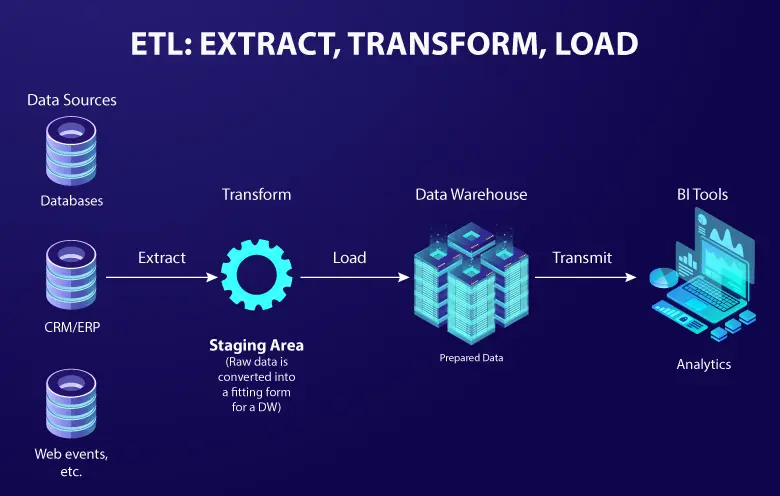Today’s businesses cannot survive and thrive without digital transformation. It is essential to stay competitive and deliver value to customers. Data is reshaping the landscape of business and transforming how we interact. Every online click, social media post and e-commerce transaction generates a treasure trove of valuable information, leaving an indelible mark on the digital canvas.
Understanding digital transformation
Digital transformation uses technologies to fundamentally change how organizations operate, deliver products and services, and interact with customers. It is an ongoing journey of innovation, adaptation, and reinvention. It requires a deep understanding of customer needs, market trends, and emerging technologies.
Data used across industries
Data serves as the foundation for informed decision-making, personalized customer experiences and operational efficiency. Different industries are leveraging data in their own way to reap maximum benefits, for example:
The retail industry uses its data analytics insights to personalize product recommendations, optimize store layouts and enhance customer service. Customer behavior, demographics, and purchase history are used to achieve this. Retailers can recommend products that align with individual preferences.
Financial institutions use data analytics to assess creditworthiness, detect fraudulent activities, and manage risk exposure. Data-driven insights help organizations make informed investment decisions and optimize risk management strategies.
Data analytics in manufacturing is used to optimize production processes, reduce defects, and improve supply chain management. By analyzing sensor data from machines, manufacturers can identify potential problems and predict maintenance needs.
The role of data analytics services in healthcare is to improve patient diagnoses, treatment plans and outcomes. By analyzing patient data, healthcare providers can identify potential risks, predict disease progression, and personalize treatment plans.
Types of data analytics
Data analytics encompasses a range of techniques and methodologies for extracting meaningful insights from data. The four main types of data analytics are:
- Descriptive Analytics:The most basic form of data analysis, focusing on summarizing and describing data to understand its characteristics and patterns. It involves techniques like data summarization, data aggregation and data visualization.
- Diagnostic Analytics: This analysis delves deeper into the data to identify the root causes of observed trends or patterns. It uses techniques like data mining, correlation analysis, and regression analysis to uncover hidden relationships and explain why certain outcomes occur.
- Predictive Analytics: The analysis is done using historical data to predict future trends or outcomes. It employs techniques like statistical modeling, machine learning, and artificial intelligence to forecast customer behavior, market trends, or operational outcomes.
- Prescriptive Analytics: One of the most advanced forms of data analytics, aiming to not only predict future outcomes but also recommend the best course of action. It utilizes techniques like optimization algorithms, simulation modeling and decision support systems to provide actionable insights that guide decision-making.
Suggested: Which type of data analytics is most suitable for your business?
The crucial role of data as a service
Data as a Service (DaaS) empowers organizations to harness the power of data seamlessly without the burden of managing complex data infrastructure. By providing access to curated, high-quality data and advanced analytics tools, DaaS accelerates digital transformation initiatives.
DaaS eliminates the need for organizations to invest in costly data infrastructure, saving time, resources, and expertise. It also unlocks a vast array of data sources, including external datasets, enabling organizations to gain a deeper understanding of their customers, markets and operations. By leveraging DaaS, organizations can gain:
- Data accessibility: By offering centralized access to vast internal and external data, DaaS breaks barriers empowering organizations to make informed decisions and innovate with agility.
- Real-time insights: DaaS enables real-time data analysis, providing immediate insights for proactive decision-making, operational optimization, and prompt responses to evolving customer needs.
- Scalability: It allows organizations to flexibly scale data usage based on fluctuating needs, translating into cost-effectiveness and efficient data management.
- Cost efficiency: Ensure significant cost savings by eliminating the need for upfront investments in infrastructure, software, and personnel, enabling resource reallocation towards innovation and growth.
- Data quality and governance: Prioritize reliable, consistent, and secure data, instilling trust through stringent data governance frameworks and protection measures.
- Integration capabilities: DaaS facilitates seamless integration, breaking down data silos and providing a unified data landscape for comprehensive insights and cross-functional decision-making.
- Personalization: Get personalized data experiences, tailoring insights and recommendations based on user preferences, enhancing customer engagement and satisfaction.
- AI and analytics enablement: DaaS seamlessly integrates with AI and ML technologies, enabling organizations to extract deeper insights, automate analysis, and receive prescriptive recommendations.
- Competitive advantage: DaaS empowers organizations with a competitive edge by leveraging data for innovation, operational optimization, and informed decision-making, crucial in the dynamic digital era.
Steps to start with
Organizations can take several steps to initiate their digital transformation journey using data as a service:
| Steps | Descriptions |
|---|---|
| Define data objectives and strategy | Clearly define the business objectives and data requirements for adopting DaaS.
This involves understanding the specific data sources needed, the types of insights to be derived and how these insights will drive decision-making and improve business outcomes. |
| Assess data readiness | Evaluate the current state of data management and infrastructure.
Identify any data quality issues or gaps in data availability. Assess the organization’s ability to integrate new data sources. |
| Build a data governance framework | Implement a robust data governance framework to ensure data quality, consistency, and compliance with data privacy regulations.
This includes defining data ownership, access control, and data usage policies. |
| Foster a data-driven culture | Take the help of expert data analysts and experts on data analysis techniques and tools.
Find a consulting partner to collaborate with to train your employees in the initial stages of implementation. |
| Choose the right DaaS solution | Evaluate DaaS providers based on factors such as data quality, security, scalability, pricing, and integration capabilities.
Choose a DaaS solution that aligns with the organization’s technical expertise, budget and data needs. |
| Plan data migration and integration | Develop a plan for migrating existing data sources to the DaaS platform.
Address data cleansing, transformation, and enrichment needs. Establish data integration processes to ensure ongoing data flow. |
| Implement data monitoring and measurement | Establish metrics to track the effectiveness of DaaS implementation.
Monitor data quality and usage patterns. Continuously evaluate and improve data governance practices. |
By following these steps, organizations can lay a solid foundation for their digital transformation journey and harness the power of data to drive innovation, growth and success.
DaaS: The future of data management
As companies recognize the value of renting data assets to gain a competitive edge, the demand for DaaS will continue to grow.
Gartner predicts that DaaS will serve as a foundation for both business intelligence and big data analytics markets.
DaaS is like other cloud-based services like SaaS (Software as a Service) and Storage as a Service. It can be used with either of these services or both. However, like other cloud-based services, there are concerns about security, privacy, and proprietary issues that may limit its adoption.
DaaS: Empowered by data, driven by innovation
Data as a Service empowers organizations with access to curated data, advanced analytics and transformative insights. With customized DaaS solutions, organizations can unlock a world of possibilities, driving innovation, optimizing operations, and establishing a competitive edge in the ever-evolving digital landscape. Connect with our data experts to navigate a seamless data transformation journey, where possibilities meet technological excellence.



